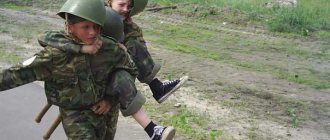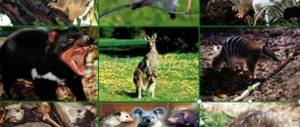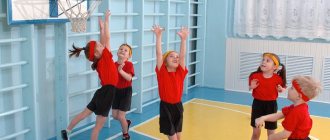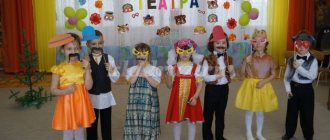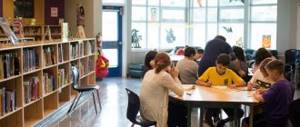The main portal for children's parties in Yekaterinburg
Every time, preparing for a children's event in the open air, the question arises - what can children do to make it interesting and fun for them? To have somewhere to throw out your ebullient, irrepressible energy. A sports relay race under the code name “Fun Starts” could be an excellent solution. The competition program, as a rule, includes various competitions, relay races and outdoor games. It is desirable that most of the relay races be different in different groups, but no more than 10–13 tasks in grades 1–3 and no more than 13–18 tasks in grades 4–6 and 7–9.
The following tasks and competitions are traditional:
— presentation of teams by captains (emblem, motto, uniform, greetings for the jury and opponents). — warm-up (participants guess riddles, answer questions from the areas of “Physical Education”, “Sports”, “Healthy Lifestyle”). — captain competition (captains compete in various physical exercises and answer questions about sports). - competitions “The Strongest”, “Most Accurate” (usually held in the middle of the competition, so that participants can rest after the running relays and cheer for their competition participants) - competitions “Team Drag”, “Fan Drag” usually complete the program “ Happy starts."
If desired, you can vary the number of commands. Staff them with a suitable number of people. These can be either teams exclusively of girls or boys, or mixed versions. You can even include adults in teams in equal numbers.
Below we want to list the most famous relay competitions so that you can choose those that you think children will enjoy the most.
Night orienteering
At a distance of 10 meters from the start, a stool is placed and the first participants close their eyes. At the signal, they must walk or run to the stool, walk around it and, returning on command, pass the baton to the next participants, who are already standing blindfolded. And so does the whole team. While moving, the team can help its participants by shouting: “to the right,” “to the left,” “forward,” “backward.” And since all commands are shouting at the same time, the player must make out which calls apply specifically to him. When the last player returns to the starting line, it is “day” for the entire team. For whom the “day” comes earlier, they won.
Cheerful cooks
For this attraction you will need two chef's hats, two jackets or two white coats, and two aprons. Items are laid out on stools located on the starting line, on opposite stools they place a mug filled with water, a wide-necked kefir bottle, and a tablespoon. The competition participants are divided into two teams. They line up at the starting line. At the presenter’s signal, the first numbers run up to the stool, put on a cap, jacket and apron and run to the opposite stools. Then they take spoons, scoop water from a mug once and pour it into a bottle, after which they return to their team and undress, handing the second number an apron and cap. He quickly gets dressed and performs the same task, etc.
No worse than a kangaroo
You need to run, or rather, jump a certain distance, holding a tennis ball or matchbox between your knees. Time is recorded by clock. If the ball or box falls to the ground, the runner picks it up, pinches it again with his knees and continues running. The one with the best time wins.
Without deviating from the route
Players from both teams line up in chains behind each other's heads. A 5-6 m long line with a circle at the end is drawn against each team on the ground. At the leader’s signal, team members run one after another exactly along the line to the center of the circle. Having reached it, they raise their right hand and, looking up, begin to spin. Having made 5 full turns in place, they run back along the line, again trying not to leave it. The team that finishes the competition the fastest wins.
Hockey players
For the relay race you will need plastic bottles of different sizes, empty and filled with water (6-7 pieces). Bottles of water are placed in a straight line every 1 meter. At the end of the path, a gate is installed or marked. Two teams each get a stick. The first player’s task is to use a stick to bring an empty plastic bottle, skirting obstacles like a snake, to the goal (to score), then return to the team and pass the stick to the next “hockey player.” The fastest team wins.
Balloon relay
2-3 teams of 5-6 people can participate in the relay race. Stages of the relay: 1. The first stage is to carry the ball on your head. If you fall, stop, pick yourself up and continue moving again. 2. The second stage is to run or walk and throw the ball through the air. 3. The third stage is to carry two balls, pressing them together, between your palms. 4. The fourth stage is to drive the ball along the floor, going around the towns arranged like a snake (skittles, toys). 5. The fifth stage is to go the distance with a ball tied with a meter-long thread to the ankle. 6. The sixth stage is to carry the ball on a table tennis racket or in a large spoon. 7. The seventh stage is to hold the ball between your knees and jump with it like a kangaroo.
Rhythm relay race
A relay race between two or more teams that line up in columns in front of the starting line. The first team members have gymnastic sticks in their hands. At the signal, the players run with them to the stand located 15 m from the starting line, run around it and return to their columns. Holding the stick by one end, they carry it along the column under the feet of the children, who, without moving from their place, jump over it. Once at the end of the column, the participant picks up the stick and passes it to the partner standing in front of him, who passes it to the next one, and so on until the stick reaches the player leading the column. He runs forward with a stick, repeating the task. The game ends when all participants have run the distance.
From one to five
This is a fun competition with plastic balls of different sizes. To play you still need two plastic sticks. Two teams of five people compete. The first players must use a stick to move one ball about seven meters. There is a large mace at the finish line, and the participant must go around it and return to his team. The second player is already dribbling two plastic balls, the third – three, the fourth – four, the fifth – five. It's very difficult, but exciting. The team that manages to shoot the most goals wins.
Mushroom pickers
A relay race in which two teams participate. At the finish line, three towns are placed for each team and covered with colored circles - these are “mushrooms”. The first player at the start also has three circles in his hands, but of a different color. The player runs to the finish line, changes the caps of the “mushrooms” and returns, passing the circles to the second player. If the “mushroom” has fallen, then the movement cannot be continued. The team that was faster and more careful wins.
Simple matter
Two teams line up at the starting line. The first player receives a bowl filled with water and, at a signal, begins to run, trying not to splash the water. At the finish line, 15-20 steps apart, there are three stools or benches at some distance from each other. The player places the plate on a stool, crawls under it (if a bench is used, then steps over it), rearranges the bowl, etc. Then, taking the plate, he returns back. The second player starts running. If a team finished the relay earlier, but there was less water in the bowl than their opponents, then the game ended in a draw.
Population census
Teams compete on a relay basis. Participants run to where there is a sheet of paper and a thick marker. The person who has reached the point writes down the name of any member of his team (except himself and those already written down) and, taking the marker, runs back and passes it to another participant. It's very funny how the last players struggle to remember whose name has not yet been written down. The game allows you to better remember the names in the new company.
Umbrella racing
Two teams take part in the relay. Two players simultaneously run from each team, holding an open umbrella above them. The umbrella is passed to the next couple like a relay baton.
Waiters
Two teams are given a round tray and 15-20 empty plastic bottles of different sizes. The first player takes the tray with one hand, places one bottle on it, puts the other hand behind his back and begins to move towards the table located at the opposite end of the room. Having reached the table, the “waiter” puts down the bottle and runs back to the team with the tray. The second player repeats these actions. It is prohibited to hold the bottle with your hand. When a bottle falls, the player returns to the team and takes another one. The team that serves their table the fastest wins.
Book races
The relay requires two small balls and two books. Two teams are formed and line up on the starting line. Each team player races with a ball between their knees and a book on their head. If the book falls, the racer stops, puts the book on his head and continues moving. The fastest team wins.
Potatoes in a spoon
You need to run a certain distance, holding a spoon with a large potato in your outstretched hand. They run in turns. The running time is recorded on the clock. If the potato falls, they put it back and continue running. You can't run without potatoes! The one with the best time wins. It will be more interesting if it is a team competition.
Postman on horseback
Two teams of postmen line up at the start, and on command they saddle a stick and hold a balloon between their knees (it turns out to be a “horse”), put on a hat and take a bag of “mail” in their hand. Trying not to drop anything, players move to the turning piece and return back to hand the mail to the next postman. If a player loses at least one attribute, he stops, equips himself, and only then continues moving. The team that delivers the mail the fastest wins.
Dive into the hoop
Relay race. Team players take turns pushing the hoop from start to finish and at the same time try to slip into it as often as possible, from one side to the other. Each dive brings the team one point, but if the hoop falls, then this point is deducted, and the race continues from the place of the “accident”.
Join our VKontakte group and you will always be in the thick of the most interesting events for children in Yekaterinburg! And for the weekend we are preparing a Poster of the best children's events.
Other useful portal materials
Where to spend the birthday of a child from 1 to 18 years old
Everything you need to organize a great graduation ceremony
“Ice skating relay races for children” methodological development in physical education on the topic
Koroleva Marina Igorevna, MBU DO "Youth Sports School "Vostok" Tula, trainer-teacher
ICE RELAYS
"Collect the cubes"
Teams line up at the starting line. In front of each team, cubes are placed at a distance of 15-20 m (according to the number of participants). On command, the participants start moving, run to the cubes, take one and, returning to the team, pass the baton to the next one. The team that collects all the cubes first wins.
"Who's next?"
Participants line up on a marked line 10 meters from the start line and begin to accelerate one by one and, having reached the start line, switch to sliding in one of the prescribed ways (in a squat, moving your leg back, etc.). The one who manages to slip further wins.
"Around the Cone"
Teams line up at the starting line. In the middle of the distance, a large cone is placed in front of each team. At the signal, children begin to move to the cone, run around it and run to the finish mark. Having run around the finish line, the participants return to their teams and pass the baton to the next one. The team that finishes the run faster wins.
"Obstacle Course"
Opposite the teams it is necessary to install the same obstacles: a stick, a goal, 5-6 cubes, placed one after the other at a distance of 1 meter. At the signal, the participants must jump over the stick lying on the ice, run to the gate, slide on their feet under the gate without touching the top bar, and, having circled the cubes in a “snake”, return back to the team, passing the baton by touching the shoulder of the next participant.
"Hockey Players"
Teams line up at the starting line. At a distance of 20-25 m from the starting line, cones are placed opposite the teams. The first and second numbers of both teams each hold a hockey stick in their hands, and the first number also holds a puck.
At the signal, the first numbers move the puck with their stick, go around the turning cone and drive the puck back to the starting line. It is necessary that the competitor dribbles the puck rather than sending it forward with his stick. When the puck crosses the starting line, the second team number takes over the baton. And at this time, the first number passes the stick to the third number, etc. until the last player. The winners are those whose last number, returning from the cone, crosses the starting line before their opponents.
"Crossing"
Teams line up at the starting line. Team captains stand at the finish line. On command, the captains run to their teams, take the hand of the first team member and run with him to the finish line. The captains remain at the finish line, and the first players run after the second players, together they run to the finish line, where the first player remains, and the second runs after the third, etc. until the whole team has crossed.
"Locomotive"
Teams line up behind the starting line. The members of each team firmly hold hands. On command, participants rush forward to the finish line. Victory is awarded to the team that reaches the finish line without releasing their arms. The team that releases its hands is considered the loser.
Used Books:
- Makarenko B.N. Speed skating: Educational and methodological manual. – Kolomna, 2005 – 228 p.
- Skating. Program for children's and youth sports schools and specialized children's and youth schools of the Olympic reserve. (Methodological part) - M.: “Physical education, education, science”
- Ilyina L.E. Structure and content of the educational and training process for speed skaters in the initial training groups of sports schools: Author. dis. ...cand. ped. Sci. — Malakhovka, 1990.
- Pustynnikova L.N. Skates in kindergarten. - M.: Physical culture and sport, 1979.
Preview:
Outdoor games on ice
The development of motor skills in skating is greatly influenced by games on ice. Thanks to them, qualitative and quantitative changes in skating movements occur more intensively. In the game, the child acquires the ability to rationally use his strengths and capabilities while moving on the ice. He acts at ease and performs various movements more boldly.
In games, the development of technology comes unnoticed - in a moving, varied emotional environment, in an atmosphere of laughter and fun. This is why the game method at the initial stage of learning to skate is so important in lessons with kids. This makes it easier and faster for children to learn skating techniques, since game motor tasks are more understandable to children.
A variety of outdoor games are used at the skating rink. Among them, three groups can be distinguished: exercise games, outdoor games and relay games.
Springs on ice
The players stand on the same line; a second line is drawn with paint at a distance of 5-8 m. At the signal, children run to the colored line, after which they switch to double-support sliding. When sliding, children do 3-4 springy squats, moving their arms forward, then return to the place where they started the run. You need to glide on parallel skates (legs spaced as wide as your feet).
Options:
a) when sliding on two legs, jump and slide further;
b) when completing the task, introduce the element of competition “Who is better and faster.” 4 - 5 children who completed the exercise correctly and quickly win.
Collars
The players are divided into two teams. One of them is lined up at a distance of 5-8 m from the starting line. Children hold hands, forming collars. The rest are placed - each against their own collars - and begin to take off. They crouch down near the collars, put their hands forward and drive between them, trying not to touch them. The one who correctly completed the task wins. After playing the game 2-3 times, the children change places.
Option: having passed the gate, the children run up again and make a jump.
Giant Steps
At the signal, the players begin to move forward to the designated place, trying to keep the steps large. To do this, you need to put your hands behind your back and glide on one skate for as long as possible. The winner is the one who covers the specified distance in fewer steps.
Children first practice skating one after another, then, standing in a line, compete with each other both in the number of steps and in the speed of sliding.
Sliding down the corridor
On the surface of the ice, a straight corridor 10-15 m long and 0.5-0.7 m wide is marked by two snow rollers. The players stand at a distance of 8-10 steps from one of the ends of the corridor. They take turns taking a running start and gliding down the corridor on parallel skates, trying to slide straight without touching the snow roller.
Options:
a) you can slide along the corridor on one leg, alternating the right and left legs;
b) when entering the corridor, you need to sit down;
c) slide along a winding corridor.
Snake
On a straight segment, place 5-6 snowballs (colored ice floes, stands with flags) at a distance of 0.5-1.5 m from each other. At a distance of 10-15 m, and then 5-8 m from the outermost snowball, a starting line is drawn where the players stand. At a signal, the children take turns running and sliding on two legs between the snowballs, going around them either from the right or from the left. In this case, the legs must be kept together, tilting the skates in one direction or the other. Children can randomly choose the side from which they go around the first obstacle. Returning back, they turn in the natural direction of movement, determined by going around the last obstacle.
Options:
a) you can go around snowballs on one leg if the distance between them is small;
b) drive around in pairs with the element of competition “Who is the fastest”.
Don't touch me
On a straight segment, place 4-5 snowballs at a distance of 1-1.5 m from each other. The players stand one after another 15-20 steps from the outermost snowball (on either side). At a signal, children take turns making an energetic run and gliding in a straight line on two skates placed parallel. When approaching the snowball, the child should spread his legs wider so as not to touch it. Having passed all the snowballs, the child makes a turn and returns to the starting place.
Keep your feet down
The players line up and, at a signal, move forward to the opposite side of the rink, without lifting their feet from the ice when sliding. The winner is the one who covers the distance (no more than 12-15 m) faster than others. Forward movement is achieved by transferring the weight of the body from one leg to the other.
Option: move backwards also by energetically transferring the weight of the body from one leg to the other. The distance for sliding can be no more than 5-6 m.
Train
The players are divided into 4-5 subgroups of 5-6 people. Each subgroup forms a column, everyone joins hands (the left hand with the right hand of the person in front) and begins to slide along the route indicated by the coach. Movements must be coordinated. Children who have the skill of skating should be placed in front of the column. It is necessary for 2-3 subgroups to determine the direction of movement along the edges of the skating rink, the rest slide in the opposite direction along the lines of the drawn rectangle. The winner is the subgroup in which the children performed the movements in a coordinated manner and never separated the chains.
Flashlights
The players line up in lines of 3-5 people. At a distance of 3-4 m from the starting line, to the left and right of the guys there are stands with flags. Children run up to this point, then switch to double-support sliding (up to 1-1.5 m), after which they must drive around 2-5 snowballs laid out on the skating rink. Near each snowball, you must first spread the toes of the skates, connect the heels, then bring the socks together, spread the heels and repeat the same movement again - “flashlight”.
The distance between the snowballs gradually increases (from 0.5 m to 1 m). Subsequently, immediately after the run, the children switch to a similar slide.
Option: at a distance of 10-15 m without visual references, children perform an arbitrary number of movements with a “flashlight”. The one who has the most wins.
Everyone to their own snowball
The players line up in a line of 3-4 people. Everyone places a snowball at a distance of 10-15 m from the starting line. Having made a run up to 5-8 m, children switch to two-support sliding. After this, they drive around the snowball on the right side, making a left turn. At the same time, the skates lean towards the snowball, the left skate is on the outer edge, the right skate is on the inner edge, the body is tilted to the left. When repeating, children make a turn to the right, going around the lump on the left side.
Option: after a run, children drive into an arc made of snow (length 30-40 cm).
Herons
The players stand in a line. At the coach’s signal, they begin a run-up, pushing off with one foot to the circle drawn on the ice. Then the children switch to single-support sliding, bringing forward the pushing leg, bent at the knee. Half-bent arms are spread to the sides. The child who stays on one leg longer wins. You can maintain longer balance by alternately bending and straightening your torso.
The game “Swallows” is organized similarly to this game. Children can push off with either foot.
Make a figure
The players stand in a line. At the teacher's signal, the children run forward. After the run, they glide in different ways: on one skate in the “heron”, “swallow” pose, on two skates in a deep or small squat, with their arms stretched forward, clasping their knees with their hands. The one who can slide the longest wins.
Collect it quickly
The players are divided into two teams. Each team has 2-3 snowballs or colored pieces of ice laid out in one row at a distance of 40-50 cm at a distance of 6-8 m from the starting line. At the signal, the first of the teams run up and slide on two legs, trying to quickly collect snowballs and pass them on to the next children in the team. Those who receive snowballs quickly lay them out, stand at the end of the column, etc. The team that finishes the task the fastest wins. The number of items to collect must be increased gradually.
Pistol
Children line up in lines of 4-5 people. At the teacher’s signal, they run up at a distance of 3-4 m and near the line drawn on the ice, squat down and slide, stretching one leg forward. The winner is the one who travels the farthest.
After children have mastered the games listed above, you can move on to collective outdoor games with rules. In these games, children skate around the entire skating rink, making turns and braking as necessary. At first, games are played without catchers. After the children have learned the rules of skating together around the entire skating rink, you can organize the games “Tag”, “Ice Houses”, “Day and Night”, “Mousetrap”, “Catch the Swallow”, in which children must quickly run away from the trap.
Find yourself a match
Children skate one after another along the edges of the skating rink. At the coach’s signal, “one, two, three—find a pair,” the child pairs up with the one sliding from behind and crosses his arms with him. Each pair glides at the same pace. After 30-40 seconds they again form a column. The game is repeated 4-5 times. It is necessary to ensure that children ride not only in a counterclockwise direction, but also in the opposite direction.
Option: children skate all over the skating rink, at the coach’s signal they find a partner and continue skating one after another along the edges of the skating rink.
Top
Children are divided into two teams, which line up on opposite sides of the rink (one team opposite the other). At the coach’s signal, children from both ranks run up and slide towards the middle of the rink towards each other. In the center, a child from one rank takes the hand of a child from another rank (they touch opposite shoulders to each other) and turns around themselves like a top, without taking their skates off the ice. The pair that makes the most turns wins. After completing the spinning top, the children return to their places and the game is repeated.
Circles and stars
Children skate all over the skating rink. At the “circle” signal, they gather around a circle drawn on the ice, having first found a mate. Holding hands, the children spin around, then run scattered again; at the “star” signal, each pair is placed at the edges of the rectangle. At the same time, standing facing the center of the rink, children connect their right and left hands at the top, and move their other hands to the sides.
Astronauts
Children are divided into four teams of 5-6 people, determine their cosmodrome in the corners of the skating rink (place flags of a certain color in the snow bank). Then everyone gathers in a large circle in the middle of the skating rink. To the words of the coach: “Fast rockets for walking on the planets are waiting for us. We’ll fly whichever one we want. But there is one secret in the game - there is no place for latecomers” - the children slide in a circle, pushing off with one foot, after the words “there is no place,” each team of astronauts hurries to their cosmodrome, the players stand one after another behind the commander and slide behind him in different directions of the skating rink. Those who are late for the cosmodrome remain in the center of the skating rink and wait for their comrades to return. The game starts again. Children themselves name their ships.
Catch up with the swallow
From among the players, one child is selected - a swallow, who stands at a distance of 4-5 steps from the other children. At the signal “swallow flies away,” the child runs away, and all the children catch up with her. The one who manages to touch the swallow (to grease it) becomes it. After a short break (children rest), the game is repeated.
Option: all the players stand in a line, the teacher takes each child by the hand in turn and, as it were, rolls him into the center of the skating rink. At the same time, the child makes a “swallow” figure. The winner is the one who glides beautifully and smoothly across the ice.
Ice houses
The players (maybe 5-6 children) choose a driver. Then they stand at equal distances along the edges of the circle drawn on the ice. Everyone draws a circle around themselves (with the end of the skate) - an ice house - and stands facing the center of the circle. The driver, holding a ribbon in his hands, slowly rides behind the children standing in the houses. Then he puts the ribbon on the shoulder of one of the players and runs away, trying to quickly run around the circle and take a free house. The one who was given the ribbon takes it, quickly turns around and tries to catch up with the driver. The driver becomes the one who is left without a house. If the one who is catching up manages to overtake the driver and touch him, he again occupies his house.
It is advisable to select children of equal strength for the game. During the game, children standing in a circle should not turn around. You can only run in the direction in which the driver is running. If after 3-4 repetitions of the game the driver fails to occupy the house, you need to choose another driver. This will enliven the game and give the previous driver a chance to rest.
Salochki
The driver is selected from among the players. They could be a child who is good at skating. The rest of the children are randomly located throughout the skating rink. At the coach’s signal, everyone scatters around the rink, and the driver salutes the children (touches them with his hand). Those who are insulted by the driver step aside until the end of the game. You can agree in advance with your children on the conditions for changing the driver. The driver who managed to make the specified number of children win (4-5) wins. First, the driver is appointed by the teacher.
Option: children play the same way, but the driver does not have the right to salt those who are sitting down.
Day and night
Children are divided into two teams. One is “Night”, the other is “Day”. The teams stand with their backs to each other in the middle of the field. At the “Day” signal, the “Night” team runs away to their side, and the members of the “Day” team salute (touch) those running away, and vice versa.
The team in which the largest number of children managed to make the children from the other team win wins.
Pass the puck
Children line up in 2-3 columns. In front of each column, at a distance of 5-8 m from the starting line, there is a flag on a stand. The first in the column has a stick in their hands and a puck on the ice. At the signal, the children standing in front of the column run to the flag, go around it and return back, driving the puck with their stick. The stick is passed to the next child in the column. The winner will be the team that finishes dribbling the puck first.
Competition
All players are divided into 2-3 teams, line up at the start line, at a distance of 10 m from the finish line. At the wave of the flag, the first ones run to the finish line and return to the end of the column. The team with the most children crossing the finish line first wins.
Each child who reaches the finish line first receives a flag.
Option: when running in a straight line to the finish line, children can perform a “flashlight” or “snake” movement.
We are not yet preparing for the Olympics or international competitions, and we are not even raising an athlete, but in winter we definitely take sleds, skis or skates for a walk. Riding them is already fun. But if you go to the skating rink or the slide every day, then even this can get boring. Therefore, we offer several games that both your child and the surrounding children will enjoy playing.
Let's start with the skates. The main condition is the ability to at least stay on the ice a little and not be afraid of all kinds of bumps and bruises. When your child gets tired of cutting simple circles around the skating rink, you can invite him to try himself as a figure skater and master some simple movements.
What games to play on skates?
Springs
The child runs up and slides on two skates in a straight line. While sliding, you should try to do 3-4 squats. To make it easier to maintain balance, you need to move your arms forward during squats.
Flashlights
The beginning is the same - we run up and slide in a straight line on two skates. While sliding, you need to spread your legs apart, then bring them together. There will be traces on the ice - “lanterns”. To make the drawing beautiful and form a whole garland, you need to bring both legs together and spread them at the same time.
Sliding step
First you need to slide on the ice, trying to ride as long as possible on one skate, then on the other, taking long steps. Then move forward in small steps, pushing off as often as possible. If your child is captivated by this activity, next time you can take the player for a walk and, turning on the music, come up with your own dance. Mastered movements (flashlight-springs-steps) are quite enough for this. Well, if your child gets tired of riding alone, it’s time to team up with other kids and organize ice games.
Snowflakes and ice
Before the game starts, the participants agree on what movements the children will make after hearing this or that word. For example, the driver (adult) says: “Snowflakes!” and the children raise their hands up and spin around in place, or roll to one side of the skating rink. The driver says: “Ice!” and the children freeze in place or roll to the other side of the skating rink.
Slalom
For this game you will need plastic bottles or other objects that need to be placed on the ice. Players stand according to their height, put their hands on each other’s shoulders and ride like a snake. The players' task is to go around all the objects without knocking over any.
Who is faster
A line is drawn on the ice, behind which all participants stand, and toys are placed at a certain distance from each of them. The task of the players, at the command of the leader, is to quickly get to the object and take it. For older children, you can make the task more difficult by placing a coin on the ice. The player must pick up speed and, at full speed, without stopping, drive through and pick up the coin.
Ice dancing and mixed relay in biathlon. What to watch on Tuesday
Ice dancing and mixed relay in biathlon. What to watch on Tuesday
On Tuesday, February 20, 5 sets of medals will be awarded at the Olympics in Korea. Representatives of Nordic combined, figure skating, short track speed skating, biathlon and freestyle will compete for medals.
Photo: © RIA Novosti/Alexander Vilf
The main thing is figure skating
Russian athletes will have the best chance of winning medals on Tuesday in ice dancing. True, if the leaders do not fail, Ekaterina Bobrova and Dmitry Solovyov can only count on bronze. After a short dance, they are in sixth place, losing more than seven points to the French pair Papadakis/Cizeron, who are in second. But the Russians may well compete for third place. It is quite possible to win back a gap of just over two points. Moreover, our skaters have a very strong and sensual free program.
Bobrova and Soloviev will take to the ice fifteenth. And another representatives of the Russian team, Tiffany Zagorski and Jonathan Gureiro, will wear number nine. After a short dance, they are in 13th place.
06:30
Free program.
Dancing on Ice ( "Match! Arena"
)
Must watch
Biathlon
For the classic relay races, the Russian team does not have enough people for a full-fledged team. Only two men and two women received invitations to the Games. Therefore, our biathletes will complete their performance at the Olympics in Korea with a mixed relay on Tuesday.
Considering the progress and work on the shooting range that the Russians showed in previous races, we can’t count on medals. Of the four athletes, only one Tatyana Akimova qualified for the mass starts, and even then she took the last 30th place there. So even perfectly accurate shooting is unlikely to allow the Russians to reach the podium. But at this Olympics, anything happened.
14:05
Mixed relay (
"Match! Arena"
)
Freestyle
On Tuesday, medals will be awarded in the women's halfpipe. There is one representative of Russia in the final – Valeria Demidova. The 17-year-old athlete’s results are not yet brilliant: she is ninth in the current World Cup, and took twelfth place at the last World Cup. But freestyle at the Games is even more unpredictable than biathlon. World champions and previous Olympics champions did not reach the decisive stages in various disciplines, and those from whom medals were not expected reached the podium. Therefore, Demidova is able to present a surprise. She qualified for the final from tenth place in qualifying.
Photo: © Cameron Spencer / Getty Images Sport / Gettyimages.ru
04:25
Halfpipe.
Women ( "Match! Our Sport"
)
Short track
The girls will compete for medals in the relay race. Unfortunately, the Russians couldn’t make it to the final A, which means we won’t have any medals in this discipline. But on Tuesday, the important qualifying races for the men's 500 meters and women's 1000 will start. The competition will begin with the girls' performance. Ekaterina Efremenkova will take the start in the third race, and Sofya Prosvirnova in the sixth. In the men's 500-meter competition, our team has three representatives in qualification: Alexander Shulginov (fifth race), Pavel Sitnikov (sixth) and Semyon Elistratov (eighth). Medals in these disciplines will be awarded on February 22.
12:55
1000 m, women.
500 m, men. Qualification ( "Match! Our Sport"
)
Also interesting
Hockey
The Russian team recognizes its opponent in the quarterfinals. Although this opponent is easy to predict. The Slovenians are the clear favorites in the match against Norway, and most likely they will play against us in the second stage of the playoffs. Let us remind you that our team defeated the Slovenes in the preliminary round with a score of 8:2.
Photo: © RIA Novosti/Konstantin Chalabov
Much more interesting will be the confrontation between the US and Slovakia teams. They met in the group stage, and the Americans won by only one goal (2:1). Now reaching the quarterfinals is at stake. The winner of this pair will play against the Czech team.
06:00
USA - Slovakia.
Men ( Match TV
)
10:30
Slovenia – Norway.
Men ( Match TV
)
Bobsled
The girls will complete their first and second attempts. The favorites here are the teams of Germany, Canada and the USA, but let's cheer for two Russian crews: Sergeeva/Kocherzhova and Rodionova/Belomestnykh. It will also be interesting to watch the performance of the first ever Nigerian bobsled team. Medals in this discipline will be awarded on Wednesday.
14:45
1st try.
Women ( "Match! Our Sport"
)
15:55
2nd try.
Women ( "Match! Our Sport"
)
Photo:
RIA Novosti/Alexey Filippov, RIA Novosti/Alexander Vilf, Cameron Spencer/Getty Images Sport/Gettyimages.ru, RIA Novosti/Konstantin Chalabov
